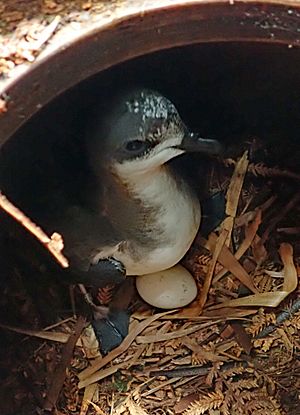Chatham petrel facts for kids
Quick facts for kids Chatham petrel |
|
|---|---|
 |
|
| Conservation status | |
| Scientific classification | |
| Genus: |
Pterodroma
|
| Species: |
axillaris
|
| Synonyms | |
|
|
The Chatham petrel (its scientific name is Pterodroma axillaris) is also known as ranguru in Maori. This medium-sized bird is a type of gadfly petrel. It has grey, white, and black feathers. You can only find this bird on the Chatham Islands in New Zealand. For a long time, it only lived on Rangatira Island, also called South-East Island. This island is about 218 hectares big.
Contents
What Does the Chatham Petrel Look Like?
The Chatham petrel is a medium-sized seabird. Its forehead is a mix of dark grey and white. Its back and the top of its wings are dark grey. The underside of its body is white.
Look closely at its wings! There's a black stripe that goes from the front edge of its underwing to a black spot that looks like an 'armpit'. Its shoulders and the top parts of its wings are a darker grey. This creates a dark 'M' shape when the bird spreads its wings.
The petrel has a black beak with a strong hook at the end. Its eyes are dark. Its legs and feet are pink, but the outer toes and the webs between them are dark. Male and female Chatham petrels look the same. These birds are rarely seen far from their nesting areas.
How Do Chatham Petrels Breed?
Chatham petrels make their nests in burrows. These burrows are usually found under the forest trees. They often use the same burrow year after year. They use leaves to build their nests inside the burrows.
Each pair of petrels lays just one white egg. This usually happens in December or January. The young chicks then leave the nest, or fledge, in May or June.
Why Are Chatham Petrels in Danger?
The Chatham petrel population is currently about 2,000 birds. This makes them a "nationally vulnerable" species. This means they are at risk of becoming endangered.
Long ago, Chatham petrels lived all over the Chatham Islands. But when people arrived, they brought new animals like rats and cats. These animals hunted the petrels. Also, a lot of their forest homes were destroyed. Because of this, the petrels could only survive on Rangatira Island.
On Rangatira Island, the petrels faced another problem. They had to compete for burrows with another bird called the broad-billed prion. There were about 330,000 pairs of prions on the island! This made it very hard for the petrels to find safe places to nest.
How Are People Helping Chatham Petrels?
People started working to save the Chatham petrel in the late 1980s. First, they tried to find the petrel burrows. They also wanted to know why so many breeding attempts failed. They soon learned that the broad-billed prions were causing most of the problems. The prions were taking over the petrel burrows.
So, conservationists changed their focus. They started protecting the petrel burrows and chicks from the prions. They use a special method to find the burrows. Adult petrels are fitted with tiny transmitters. These transmitters help people track the birds to their burrows.
Once a burrow is found, it gets extra protection. Workers install a plastic or wooden artificial burrow. This helps stop the burrow from collapsing. They also put a special flap over the entrance. This neoprene flap stops prions from getting inside.
During the time when petrels are away for winter, their burrows are blocked. This stops prions from moving in while the petrels are gone. In the 2005/06 breeding season, 83% of the 155 known pairs on Rangatira successfully raised their chicks. This shows the conservation efforts are working!
Another important step was moving some chicks to a new, safe place. From 2002 to 2005, 200 chicks were moved to Pitt Island/Rangiauria. This area has a special fence to keep predators out. A few of these birds have now returned to the site. The first chick successfully fledged there in the 2005/06 season. By 2006/07, four pairs were breeding there.
In April 2008, another 47 chicks were moved. They went to a predator-proof fenced area on the south coast of Chatham Island. Over four years, 200 chicks will be moved to this new safe home.
See also
 In Spanish: Petrel de las Chatham para niños
In Spanish: Petrel de las Chatham para niños




